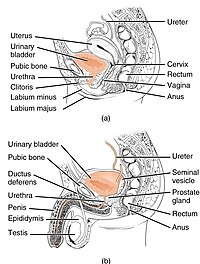
Photo from wikipedia
Congenital isolated penile curvature without associated hypospadias is rare. It was reported as 4% of the more common chordee with hypospadias. The subgroup with short urethra is even a rarer… Click to show full abstract
Congenital isolated penile curvature without associated hypospadias is rare. It was reported as 4% of the more common chordee with hypospadias. The subgroup with short urethra is even a rarer portion of the congenital penile curvature without hypospadias. Thus, there are no definitive guidelines for management of this entity. In this issue of the International Journal of Urology, Zhou et al. compared retrospectively one-stage versus two-stage segment urethroplasty in the treatment of severe chordee with congenital short urethra for managed patients between 2006 and 2020. In their interesting study, they recommended the twostage procedure compared to the one-stage in terms of the satisfactory success and complications. However, it was not a randomized study and the procedures were selected depending on surgeon’s preference. Furthermore, the different historical period for the two types of repair and the accumulating surgeon experience are important factors affecting interpretation of results. The surgeons have performed the two procedures over a period of 15 years. One-stage repair was only performed in the early period. Thus, an extra experience of 10 years was available during the subsequent two-stage repair. Another important factor was the low number of patients, which affected the reliability of statistical results. On the other hand, this disease is relatively uncommon which explains the low number of cases. Thus, a well-designed study recruiting a larger number of patients will provide more solid recommendations. Furthermore, different types of two-stage procedure could be compared including preputial flap or graft in addition to Byars’ flap.
Journal Title: International Journal of Urology
Year Published: 2022
Link to full text (if available)
Share on Social Media: Sign Up to like & get
recommendations!